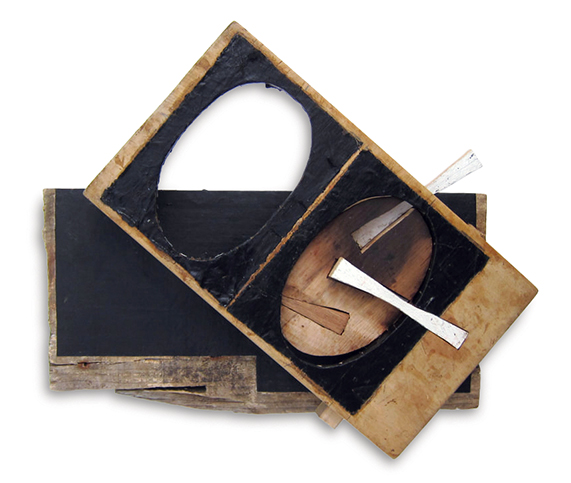Studio Visit: Paul Bowen

To reach his studio in Williamsville, VT, Paul Bowen walks a short, grassy passage between a white clapboard farmhouse and an old maple sugar shack to a c. 1850 post-and-beam barn on the edge of a meadow. Bowen navigates a dark, narrow staircase leading to a crooked door on the top-floor landing. You wouldn’t know it, but on the other side waits an expansive, light-filled studio space, bright with cathedral ceilings, wide skylights, and white sheet-rocked walls.
It’s surely the most luxurious studio, in terms of sheer square-footage, he’s had to work in. But it’s filling up with ever more materials—more and more broken bits of wood and metal—all the time. “On opening the door most people are surprised to find such a big space,” Bowen says. “When I first saw it, it had stood empty for some time, after the previous tenant had made serious alterations to the old ramshackle space, turning it into an amazing, light filled studio and then deciding not to pursue painting.”
It’s been 15 years since he moved here with his wife, writer Pamela Mandell, and it’s no surprise that Bowen seems as comfortably settled as if he’d never lived or worked anywhere else. He strikes you as one of those people you know will never change—or rather, who you know will always go on changing continuously and adapting to whatever presents itself next. It’s the same with his sculpture. He doesn’t want to wrestle something into existence so much as to rediscover the overlooked and make it new. He excels at inventing transformative uses for the given.
Bowen happily shares his studio grounds with a variety of wildlife, including deer, groundhogs, possums, and a family of foxes living under the foundation. There’s at least one bird’s nest lodged in the ground floor eaves and enough room for several horse-and-carriages. The upstairs studio walls display the cubistic sculptures for which the artist is well-known: funky, abstract combinations of sea-smooth or tar-blacked pieces of shipwrecks, tide-worn planks and spools married to fragments of pier pilings, honey-colored fish crates, and other mostly wooden debris scavenged from Cape Cod’s shores. Bowen’s sculptures reside in major museum collections, including the Guggenheim in New York, the Museum of Fine Arts, Boston, and the Harvard Art Museums. Provincetown’s Albert Merola Gallery mounted another of many highly successful shows of his work in summer 2020.

Bowen is known for working a peculiar magic upon mundane, discarded detritus no one else would even notice. His marvelous constructions emanate a shy lyricism tinged at times with whimsy and always displaying a beguiling balance of strangeness and inevitability. He proceeds by an intuitive, slow motion process. To begin, he creates the ideal conditions for accretion and attraction between disparate objects. He surrounds himself with boxes of metal or shells, bone, discarded doll parts, piles of age-stained boards and hoops; one day he puts a broken clay pipe next to an orphaned tool handle. Later he happens to move something from a pile in this room to another in that until, like images in poetry, meaning and emotion emerge inexplicably, and a new piece takes shape beneath his hand. As he tells it, it’s nothing short of accidental. “Stumble over things enough to have mishaps and, you know, things happen,” he says. Looking over his long and consistent career, of course, one knows it’s nothing of the kind.
Vermont seems at first an odd place to find a beachcomber-artist. And yet, Bowen is still picking up driftwood, only now it’s from the banks of Rock River, a modest tributary of the Connecticut, a stone’s throw from the house. Instead of broken oars and fish-boxes, the river yields storm-battered bits of bee-keeping boxes, floorboards, and barn siding. “Hurricane Irene provided tons of material cast up on the riverbanks here,” he says. “My storage is out of control.”
Now approaching 70, Bowen remains open to whatever comes. “It would be nice to say after over 50 years of doing this, that I am more sure about who or what I am, but actually I am pulled in various directions at once,” he says. “On one hand I wish I could be Vuillard, painting my own domesticity, small scale, observing what’s around me, a plein-airish kind of thing. Then I look as the vast amount of material I have accumulated over the years—barns full! And I think—well, it’s now or never!”
Videos
Christopher Volpe is a New Hampshire-based artist, teacher, and independent scholar. He publishes scholarly articles, catalogue essays, poetry, and reviews in regional and national print and online publications.
Paul Bowen
paulbowen.org
